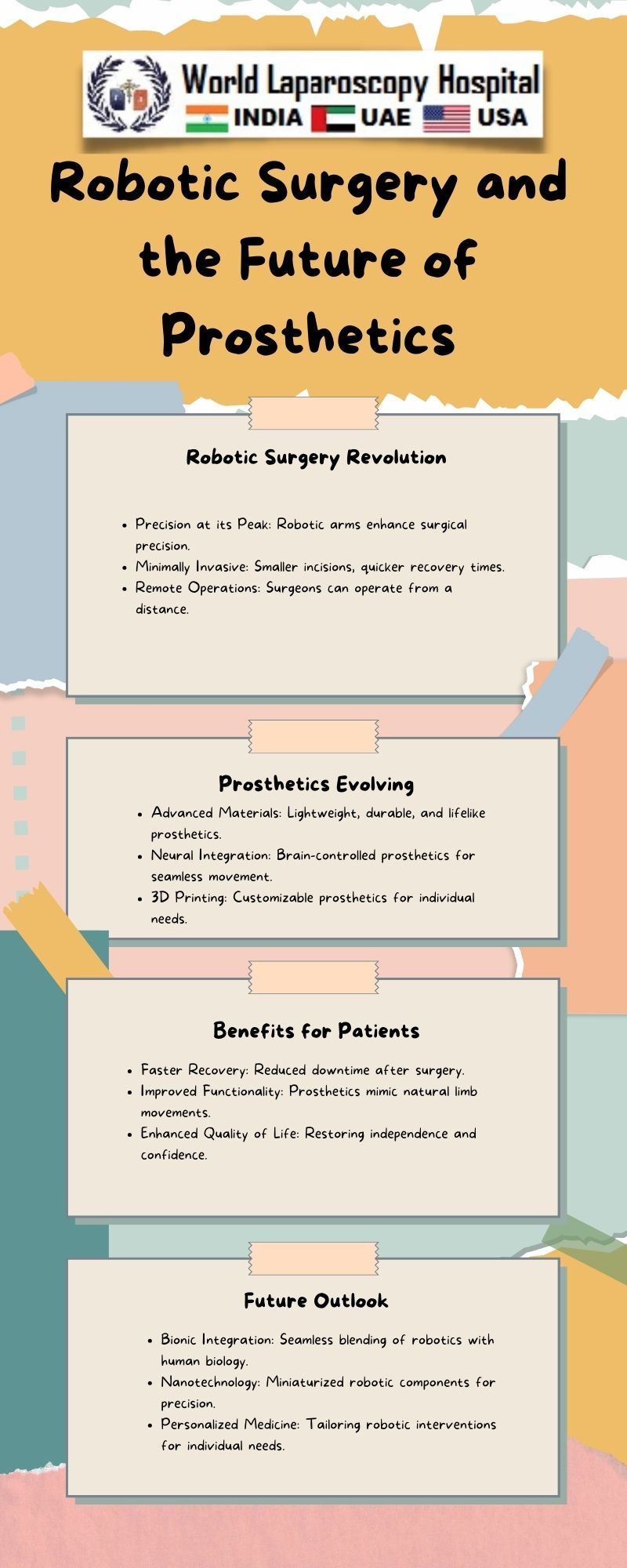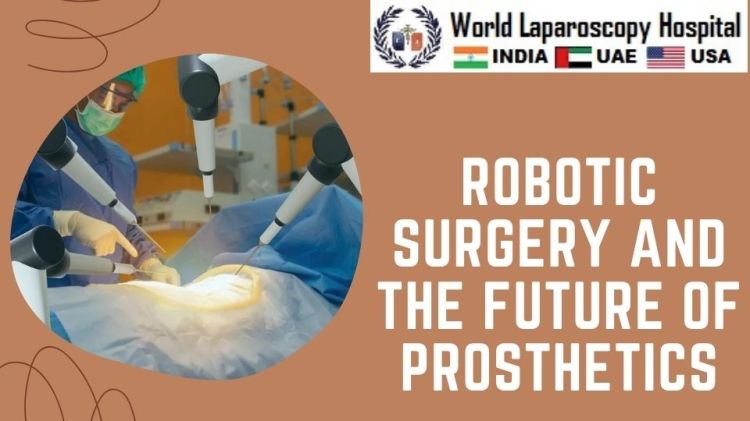Robotic Surgery and the Future of Prosthetics
Introduction:
In the realm of medical advancements, the fusion of technology and healthcare has paved the way for groundbreaking innovations. Among these, robotic surgery and prosthetics stand out as remarkable achievements that have transformed the landscape of patient care. As we delve into the intricacies of these two domains, we will explore the current state of robotic surgery, its applications, and the exciting future it promises. Simultaneously, we will journey into the realm of prosthetics, unveiling the strides made in replicating and enhancing human capabilities through artificial limbs and envisioning what the future holds for this field.

Robotic Surgery: A Marvel of Precision
Historical Evolution:
The genesis of robotic surgery dates back to the 1980s when the first robotic system, PUMA 560, was employed for neurosurgical procedures. Over the years, subsequent generations of robotic systems emerged, each incorporating technological advancements and enhancing the precision of surgical interventions.
Contemporary Applications:
Minimally Invasive Procedures:
Robotic surgery has revolutionized minimally invasive procedures, allowing surgeons to conduct complex surgeries with smaller incisions. The da Vinci Surgical System, a pioneer in this field, enables surgeons to control robotic arms with enhanced dexterity and precision.
Cardiovascular Surgery:
The use of robots in cardiovascular surgeries has minimized the invasiveness of procedures such as coronary artery bypass grafting and mitral valve repair. This has led to reduced recovery times and improved patient outcomes.
Orthopedic Surgeries:
Robotic systems are increasingly employed in orthopedic surgeries, enhancing the accuracy of joint replacements and spinal procedures. This ensures a higher degree of alignment and implant placement, contributing to long-term success.
Advantages and Challenges:
-
Advantages:
- Enhanced Precision: Robots offer unparalleled precision, reducing the margin of error in surgical procedures.
- Minimal Scarring: Smaller incisions lead to reduced scarring and faster recovery times for patients.
- Telemedicine: Robotic surgery allows for teleoperation, enabling skilled surgeons to perform procedures remotely.
-
Challenges:
- Cost: The initial investment and maintenance costs associated with robotic systems can be prohibitive for some healthcare facilities.
- Learning Curve: Surgeons require specialized training to operate robotic systems effectively, contributing to a learning curve.
The Future of Robotic Surgery: A Glimpse into Tomorrow's Operating Rooms
Artificial Intelligence Integration:
As artificial intelligence (AI) continues to advance, its integration with robotic surgery is poised to be a game-changer. AI algorithms can analyze vast datasets to assist surgeons in real-time decision-making, enhancing precision and outcomes.
Nanorobotics:
The advent of nanorobotics holds promise for further miniaturization of robotic systems, allowing for microscopic interventions at the cellular level. This could open avenues for targeted drug delivery and precise interventions in inaccessible areas of the body.
Haptic Feedback and Sensory Enhancement:
Future robotic systems are likely to incorporate advanced haptic feedback mechanisms, providing surgeons with a sense of touch during procedures. This sensory enhancement can further bridge the gap between human intuition and robotic precision.
Prosthetics:
Restoring Functionality with Artificial Limbs
Historical Evolution:
The history of prosthetics traces back to ancient civilizations, where rudimentary artificial limbs were crafted for amputees. Advancements in materials and technology have propelled prosthetics into the modern era, offering more sophisticated and functional solutions.
Bionic Prosthetics:
The integration of bionics with prosthetics has enabled the development of artificial limbs that mimic natural movements. With sensors and myoelectric technology, users can control prosthetic limbs with their muscle signals, providing a more intuitive and responsive experience.
Mind-Controlled Prosthetics:
Emerging technologies, such as brain-machine interfaces, are paving the way for mind-controlled prosthetics. By decoding neural signals, amputees can seamlessly control the movements of their artificial limbs, restoring a sense of natural mobility.
Challenges and Innovations in Prosthetics
Challenges:
Affordability:
High costs associated with advanced prosthetics pose a significant barrier to access for many individuals in need.
Ensuring seamless integration with the human body remains a challenge, particularly in terms of materials and sensory feedback.
Innovations:
3D Printing:The advent of 3D printing has revolutionized the manufacturing of prosthetics, allowing for cost-effective, customized solutions.
Neuroprosthetics:
Ongoing research in neuroprosthetics aims to establish direct connections between the nervous system and artificial limbs, creating a more natural and intuitive interface.
The Future of Prosthetics: Where Human and Artificial Merge
Biological Integration:
Advances in biotechnology may pave the way for prosthetics that seamlessly integrate with the human body at a biological level. This could involve the development of artificial limbs with tissue-engineered components, blurring the lines between natural and artificial.
Enhanced Sensory Feedback:
Future prosthetics may incorporate advanced sensory feedback systems, providing users with a heightened sense of touch, temperature, and proprioception. This could significantly improve the user experience and functionality of artificial limbs.
Global Accessibility:
Efforts to address the affordability of advanced prosthetics are underway, with initiatives focusing on providing cost-effective solutions to a broader population. This includes collaborative efforts between researchers, manufacturers, and healthcare providers.
Conclusion:
As we stand at the intersection of technology and healthcare, the trajectories of robotic surgery and prosthetics are poised to reshape the future of patient care. Robotic surgery continues to evolve, driven by the integration of AI, nanorobotics, and enhanced sensory feedback. Simultaneously, the field of prosthetics is advancing towards more natural and intuitive solutions, with a focus on affordability and global accessibility. The synergy of these innovations holds the promise of a healthcare landscape where precision meets compassion, ushering in an era where the boundaries between human and machine become increasingly blurred.






